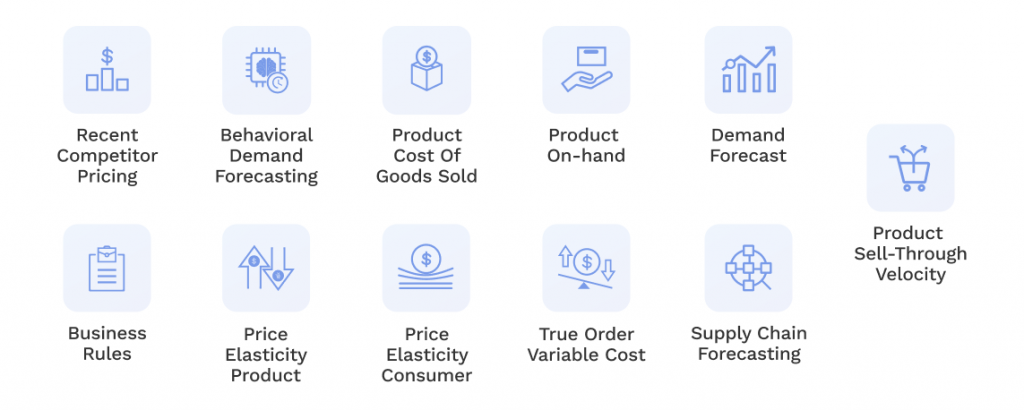How to Choose the Right Pricing Intelligence Tool
How to Choose the Right Pricing Intelligence Tool
Pricing intelligence is key to success in today’s retail market. The more a retailer knows about competitor and market pricing, the smarter that company can price its products. Pricing intelligence tools let retailers collect real-time pricing data and make immediate pricing decisions, which helps to increase sales, improve inventory turns, and eliminate dead inventory.
The question is, how does a business choose the right pricing intelligence tools? Not all pricing intelligence software performs the same or offers the same features. You need a pricing intelligence tool that fits your company’s business and enables you to make fast and informed pricing decisions. To choose the right tool, you need to know what features to look for—which we discuss in this article.
Key Takeaways
- Pricing intelligence software collects and analyzes pricing data to help you optimize product pricing and margins
- Retail and e-commerce businesses use pricing intelligence tools to enable dynamic pricing, identify market trends, maximize profit margins, and obtain a competitive advantage
- The most effective pricing intelligence tools include extensive data collection, accurate product matching, frequent pricing updates, and advanced artificial intelligence technology
What Is Pricing Intelligence Software?
Pricing intelligence involves collecting and analyzing pricing data from competitors and the market in general. This analysis can develop your pricing strategy and react to pricing changes as they happen.
Pricing intelligence tools use artificial intelligence (AI) technology to track these market dynamics in real-time. These tools employ data mining and data extraction techniques to provide the insights you need to manage your product pricing online or at retail.

The pricing intelligence process is typically split into three distinct phases:
- Price tracking, involving real-time tracking of competitor pricing
- Data analysis, which extracts key insights from the data collected
- Execution, which recommends pricing and inventory strategies based on the data analysis
The best pricing intelligence tools include robust reporting and real-time dashboards to help you visualize the data collected. You more easily gain actionable insights from the data and make more informed business decisions.
As an example, consider how Best Buy uses pricing intelligence. In recent years the company has invested tens of millions of dollars to switch from physical price tags to digital ones to change product pricing in real-time in response to real-time pricing data. Best Buy can now change prices with the click of a corporate mouse, fully optimizing all market opportunities thanks to the information gleaned from the company’s pricing intelligence software.
Why Your Business Needs a Pricing Intelligence Tool
According to Forbes magazine, 58% of the top retailers in the country plan to implement some form of pricing intelligence technology. There’s a reason for that—pricing intelligence helps increase revenues, inventory turns, and profits while lowering costs.
How, specifically, can your business benefit from pricing analysis software? Some of the top benefits include:
- Enables dynamic pricing
- Provides a competitive advantage over slower-moving competitors
- Builds market share
- Enables better-informed pricing strategies
- Helps manage overhead
- Enables price elasticity
- Identifies market trends
- Tracks prices in real time
- Maximizes profit margins
- Improves inventory management
Features to Look For in a Pricing Intelligence Tool
What features should you consider when evaluating pricing intelligence tools for your business? While every business has unique needs, you probably need six key features.
Extensive Data Collection
All pricing intelligence starts with raw data—the more data collected from a greater number of sources, the better. You want a tool that collects data about all competing products on the marketplace from all possible competitors. The information is incomplete and less useful if a tool misses a competitor. To inform the resulting analysis, you need to know what everybody in the marketplace is doing.

Accurate Product Matching
On the other hand, you don’t need to collect data on products that aren’t competitive with what you offer. Your pricing tool must accurately match your products with products from other sources and filter out those that aren’t applicable. That requires accurate product matching, so you know you’re comparing apples to apples.
Frequent Pricing Updates
Not only do you need extensive data collection, but you also need that data to be frequently updated. You don’t want to base your pricing decisions on days, weeks, or months-old data. You want to know your competitors’ current pricing so that you can react quickly.
Not all pricing tools update their data at the same frequency. While real-time pricing updates may be unfeasible from some retail sources, you want pricing data to be as fresh as possible—ideally, no more than a day old.
Historical Pricing Analysis
Knowing current pricing is essential, but it’s also important to know the historical pricing of a product or product category. Predicting pricing trends is easier and more accurate if historical pricing is also available. A full-featured pricing intelligence tool will analyze historical data to generate pricing trends and predictions.
Tracks Other Variables
Retail price isn’t the only factor that affects your pricing decisions. You compete on more than just price, so you need to know other relevant data points, including:
- Product variations (colors, sizes, etc.)
- Availability
- Delivery times
- Warranty
A full-featured pricing intelligence tool will use this and other data to analyze product assortments, promotions, and other factors that affect pricing and sales.
Uses Artificial Intelligence Technology
How does a pricing intelligence tool perform its analysis? The best software uses artificial intelligence to identify patterns and predict market trends. AI technology learns from the data it analyzes to make connections faster and more accurately than human analysts.

For example, Hypersonix uses 11 powerful AI engines to analyze and identify a variety of business risks and opportunities, including:
- Behavioral demand forecasting
- Business rules
- Demand forecast
- Price elasticity consumer
- Price elasticity product
- Product cost of goods sold
- Product cost of goods sold
- Product on-hand
- Product sell-through velocity
- Recent competitor pricing
- True order variable cost
These AI engines combined produce powerful pricing intelligence that can help you optimize product pricing and margins, increase sales, and stand out from your competition. Pricing intelligence software that doesn’t utilize AI technology merely reports, where AI-based tools drive critical business actions.
Turn to Hypersonix for Superior AI-Based Pricing Intelligence
Hypersonix is a leading provider of pricing intelligence and profit optimization software. Our AI-based solutions have helped our customers achieve 15%-18% profitable revenue growth and are available for retail, e-commerce, grocery, and restaurant businesses.
Our 11 AI engines absorb a nightly data feed, combine it with historical data, and look for anomalies that could be opportunities or represent risks. These analyses are predictive and prescriptive, so you can react quickly to maximize your revenues and profits.
Contact us today for a free demo!





